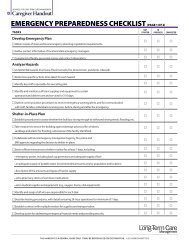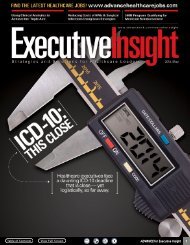ADVANCE for Executive Insight 1 ADVANCE for Executive Insight
ADVANCE for Executive Insight 1 ADVANCE for Executive Insight
ADVANCE for Executive Insight 1 ADVANCE for Executive Insight
- No tags were found...
You also want an ePaper? Increase the reach of your titles
YUMPU automatically turns print PDFs into web optimized ePapers that Google loves.
telemedicine<br />
Mercy Health has found<br />
telemedicine to be an effective<br />
way to enhance patient<br />
access to care, resulting in<br />
improved patient outcomes<br />
and decreased costs.<br />
scott frymoyer/jeff leeser<br />
Reimagining<br />
Patient Care<br />
Telemedicine brings patients and providers together.<br />
By Wendy Deibert<br />
Wendy Deibert is vice president,<br />
Telehealth Services at Mercy<br />
Health.<br />
In response to evolving changes in healthcare,<br />
hospitals and health systems are beginning<br />
to think outside the box when it comes to<br />
the best ways to deliver quality care and keep<br />
costs in check. One approach gaining traction<br />
is telemedicine—using telecommunication and<br />
in<strong>for</strong>mation technologies to provide healthcare<br />
from another location. Mercy Health has found<br />
telemedicine to be an effective way to enhance<br />
patient access to care, resulting in improved patient<br />
outcomes and decreased costs.<br />
Why Telemedicine?<br />
Mercy Health serves more than 3 million people<br />
across Arkansas, Kansas, Missouri and Oklahoma.<br />
Approximately 90 percent of the counties<br />
served by the organization are rural, presenting<br />
challenges in fostering patient access to care.<br />
We believed that telemedicine could overcome<br />
some of these difficulties, conveniently bringing<br />
patients and providers together.<br />
Our first <strong>for</strong>ay into telemedicine began in<br />
2006 when we went live with a tele-ICU program.<br />
Prior to this, we had intensivists in only<br />
one of our hospitals: The intensive care units in<br />
the other hospitals were run by consulting physicians,<br />
some of whom were not specialized in<br />
critical care. Our goal was to provide the same<br />
level of care throughout all our hospitals, and<br />
that meant we had to find a way to leverage the<br />
expertise of our existing intensivists. Research<br />
shows that ICUs with intensivists at the bedside<br />
offer better quality care in terms of lower length<br />
of stay and decreased mortality.<br />
Within 18 months of starting the tele-ICU<br />
program, Mercy brought 350 tele-ICU beds online<br />
with each bed hardwired to a wall-mounted<br />
video monitor. Through this technology, we were<br />
able to have constant intensivist coverage in each<br />
ICU. In addition, experienced critical care<br />
<strong>ADVANCE</strong> <strong>for</strong> <strong>Executive</strong> <strong>Insight</strong><br />
41









